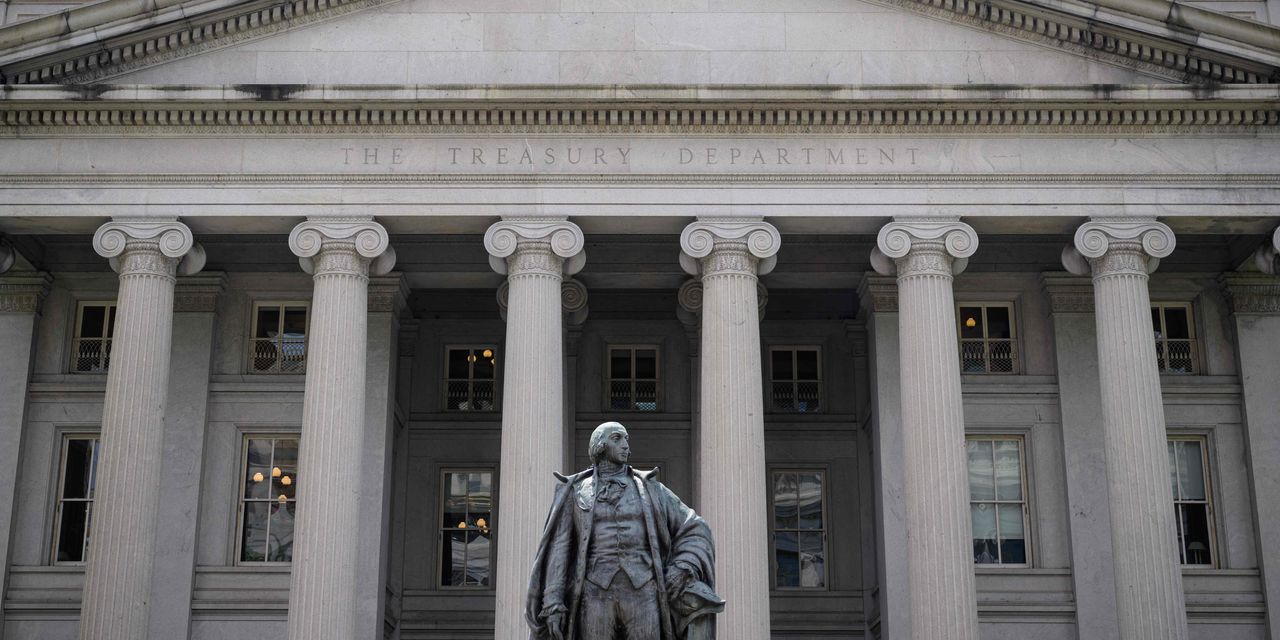The ballooning U.S. federal deficit is “worrying investors big time,” including about the bond market’s ability to finance the shortfall at current interest rates, according to Yardeni Research.
The federal deficit has swelled to $2.3 trillion on a 12-month sum basis through July, analysts at Yardeni Research said in a note Monday. That’s after narrowing to a recent low of $1 trillion through July 2022, from a record $4.1 trillion through March 2021, according to the team.
It’s “highly unusual” for the federal deficit to be rising as a percentage of nominal gross domestic product when the economy is growing and the unemployment rate is near record lows, according to Yardeni. By contrast, the deficit “always widens during economic recessions,” as tax receipts decline and outlays increase during those times as the government takes steps aimed at boosting the economy, the analysts said.
With the U.S. federal deficit now “abnormally large,” inflation would need to continue moderating for the yield on the 10-year Treasury note to remain in its recent range, according to the note.
“In a rebounding inflation scenario, the federal deficit obviously would exacerbate the rise in the bond yield,” said Yardeni analysts. “That would be a very ugly scenario for stock and bond investors as well as for the economy.”
That’s not Yardeni’s outlook, but a risk to it, according to the note.
‘Rapidly increasing supply of U.S. debt’
In the past, inflation, and expectations for how the Federal Reserve will respond to it, typically have been more important in determining 10-Year Treasury yields than the supply and demand of U.S. government bonds, according to Yardeni Research.
But the concern is whether interest rates are already high enough already to entice investors to buy the deluge of Treasurys coming to the market, the analysts said, pointing to the risk that bond yields could become more sensitive to the supply and demand of U.S. government debt.
“For now, we’re sticking with our back-to-the-old-normal bond yield forecast, based on our moderating inflation forecast, but we are increasingly concerned about the flood of Treasuries,” they said.
Read: U.S. budget deficit will double this year to $2 trillion, excluding student loans, CBO says
“The U.S. Treasury will be selling lots of notes and bonds over the rest of this year and next year, while the Fed’s quantitative tightening (QT) program will continue to reduce the Fed’s holdings of Treasuries by about $60 billion per month,” the Yardeni analysts wrote. Plus, commercial banks are letting their portfolios of securities mature, “using the proceeds to offset net deposit outflows,” according to the note.
That leaves the Treasury increasingly reliant on households and institutional investors in the U.S. and foreign investors to buy “the rapidly increasing supply of US debt,” the analysts said.
“They will undoubtedly do so,” they wrote. “The only question is whether interest rates are high enough already to attract these buyers or whether rates would have to go higher to do so.”
Yardeni analysts predict the yield on the 10-year Treasury note will trade between 4.25% and 4.50%, on an expectation that inflation will continue moderating toward 2%-3% by late next year. Ten-year Treasury yields have been trading in that range since early August, which is not high when viewed in a historical context, according to the note.
“It simply represents a return to the “old normal” yields of 2003-07, i.e., before interest rates were slashed to the “new abnormal” levels from the Great Financial Crisis through the Great Virus Crisis,” the analysts wrote. But “staying in that range when the federal deficit is abnormally large requires that inflation continues to moderate as we expect.”
The yield on the 10-year Treasury note
BX:TMUBMUSD10Y
rose three basis points Monday to 4.287%, according to Dow Jones Market Data.
“By the way, the Fed has been trying to moderate the impact of its QT program on the bond market by continuing to purchase Treasury bonds with maturities of 10 years or longer,” the analysts at Yardeni said.
U.S. equities slumped in August as 10-year Treasury yields climbed, after a strong stock-market rally during the first seven months of 2023.
Meanwhile, U.S. stocks closed higher Monday, as investors brace for an inflation reading due out later this week. The Dow Jones Industrial Average
DJIA
edged up 0.3%, the S&P 500
SPX
rose 0.7% and Nasdaq Composite
COMP
advanced 1.1%, according to FactSet data.
A reading on inflation in August, as measured by the consumer-price index, is scheduled to be released on Wednesday. Traders are largely expecting the Fed will hold its benchmark interest rate steady at a target range of 5.25% to 5.5% at its policy meeting later this month, after aggressively raising rates since early last year to fight persistently high inflation.
Read the full article here













Leave a Reply